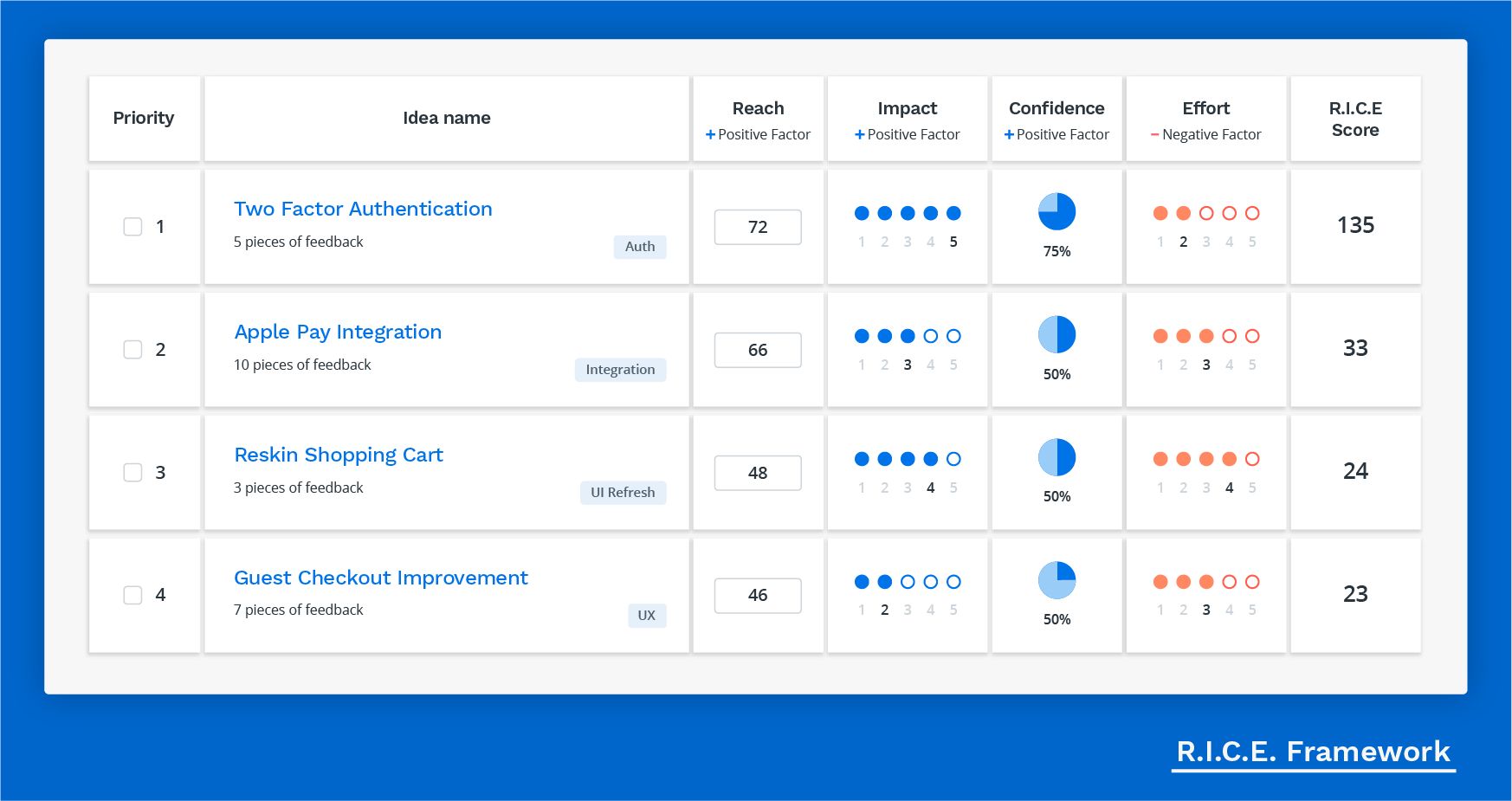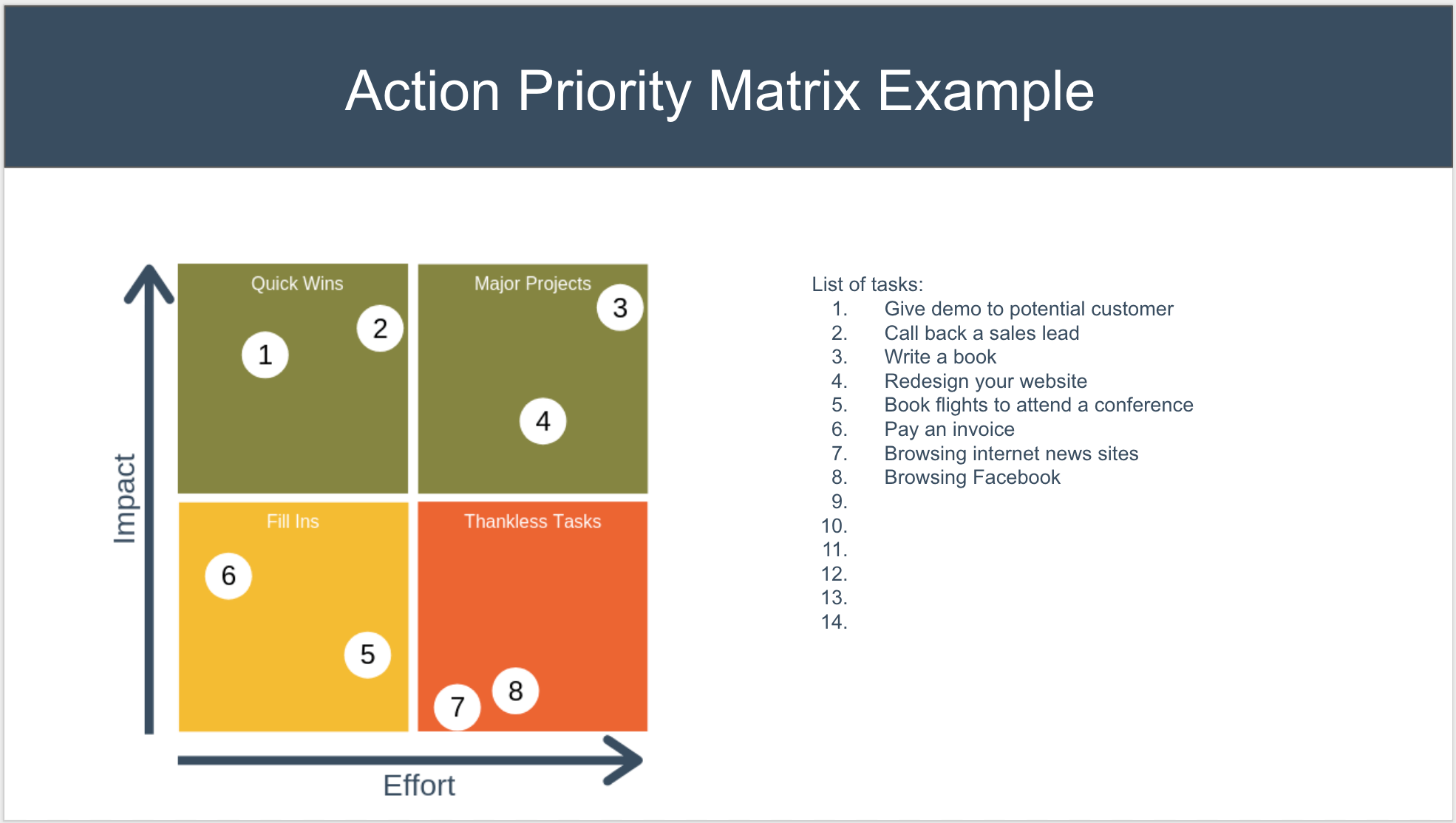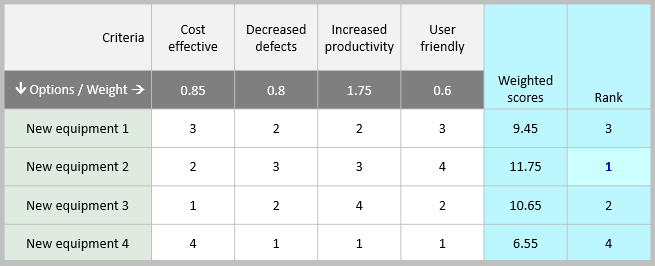Many real-life decision-making situations have several conflicting criteria that need to be considered at the same time. Traditionally, this is often dealt with by applying trial-and-error methods, or by relying on the experience of people. In such situations, decision makers are required to use prioritization in order to make effective decisions. Prioritization is an essential skill that needs to be mastered by professionals to make the best use of their own and their teams' time and effort.
The You for Youth (Y4Y) Portal is operated by Synergy Enterprises, Inc. Under Contract No. ED-ESE-14-D-0008 awarded by the U.S. Department of Education, Office of Elementary and Secondary Education.
A Prioritization Matrix is a decision-making method that allows to select the most appropriate alternative after evaluating multiple conflicting criteria. It provides a way to prioritize a list of items into an order of importance in order to select and decide further actions. It is often used in the Multi-Criteria Decision Analysis (MCDA) and other decision-making methodologies. This might be a project that you need to start, an issue that you need to resolve, or a solution that you need to implement.
Priority Bubble Chart Prioritization Matrix Criteria Ranking Class Raw Score Attribute Criteria Weight Priority Evaluation Criterion 1 Evaluation Criterion 2 Evaluation Criterion 3 Evaluation Criterion 4 Evaluation Criterion 5 Evaluation Criterion 6 Evaluation Criterion 7 Evaluation Criterion 8 Evaluation Criterion 9 Evaluation Criterion 10 9. A prioritization matrix is a 2×2 matrix designed to help you discern which tasks/projects are 'Critical and Urgent,' so you can focus on what matters most. Typically, Prioritization Matrices take the following form. Known as Intercom's internal scoring system for prioritizing ideas, RICE allows product teams.

A Prioritization Matrix helps reduce options to the most effective and least costly among the available choices. With good prioritization, you can better make use of time and resources to focus on the things that really matter. And if prioritization is implemented in a team-based manner, it allows the team to agree on the priorities and move toward the action collectively.
Developing a list of evaluation criteria is the first step before prioritizing your alternatives. These criteria represent the standards by which the different alternatives can be measured and compared. They will provide an objective and consistent basis for comparison. Brainstorming, affinity diagrams and voting can be used to generate, organize and reduce the evaluation criteria. It is important when developing the evaluation criteria to ensure that costs, benefits and risks are taken into account.
After having an agreement on the assessment criteria, you then need to weight the criteria according to importance as perceived by the team and other stakeholders. For example, when hiring a new employee, skills may weigh less than experience as it is considered by the recruitment team to be less important. The simplest way to weight the evaluation criteria is by allowing the team members to distribute a certain number of points (say 100) between the selected criteria.
In this example, each team member has distributed 100 points between the selected criteria
The prioritization matrix template is then used to list all criteria against the alternatives, attach weights to the criteria, and conduct the prioritization exercise. You may select one of the four formats for your prioritization analysis.
In this example, the team has used the prioritization matrix to select an equipment among 5 alternatives

How to Construct and Use a Prioritization Matrix
The following steps describe how to construct and use the prioritization matrix:
- Explain the purpose for constructing the prioritization matrix.
- Identify and agree on the alternatives that need to be prioritized.
- Ensure that the evaluation criteria and their weights are agreed by all.
- Facilitate the prioritization session by allowing each team member to rank the alternatives against each criteria from best to worst.
- Collect the team's rank scores, average and add them up on one worksheet.
- Calculate the final weighted scores for each alternative.
- Sort the items by their ranks to make them clearer for communication and decision making.
Note: The outcome of the analysis can be presented using a bar chart to see which alternative is the most suitable based on the scores of the team.
Example
This example illustrates a prioritization analysis that was conducted to select the most efficient data collection method at a workplace. Note that high score of cost doesn't mean that the cost is high, but low or 'cost-effective'.

Example
A manufacturing company needs to select two projects to be implemented this year. Consider the following project options and criteria:
It was agreed that ‘savings' should be given a weight of 3 as it is relatively more important than the other two criteria. In the example below, the team has used the prioritization matrix to select the most profitable among five candidate projects.
Example – Four Field Prioritization Matrix
A four field matrix can be used to prioritize and present the alternatives if you have only two evaluation criteria.
There are many tools that can help you to conduct a prioritization analysis. One of the simplest ways is to use this template.

A Prioritization Matrix helps reduce options to the most effective and least costly among the available choices. With good prioritization, you can better make use of time and resources to focus on the things that really matter. And if prioritization is implemented in a team-based manner, it allows the team to agree on the priorities and move toward the action collectively.
Developing a list of evaluation criteria is the first step before prioritizing your alternatives. These criteria represent the standards by which the different alternatives can be measured and compared. They will provide an objective and consistent basis for comparison. Brainstorming, affinity diagrams and voting can be used to generate, organize and reduce the evaluation criteria. It is important when developing the evaluation criteria to ensure that costs, benefits and risks are taken into account.
After having an agreement on the assessment criteria, you then need to weight the criteria according to importance as perceived by the team and other stakeholders. For example, when hiring a new employee, skills may weigh less than experience as it is considered by the recruitment team to be less important. The simplest way to weight the evaluation criteria is by allowing the team members to distribute a certain number of points (say 100) between the selected criteria.
In this example, each team member has distributed 100 points between the selected criteria
The prioritization matrix template is then used to list all criteria against the alternatives, attach weights to the criteria, and conduct the prioritization exercise. You may select one of the four formats for your prioritization analysis.
In this example, the team has used the prioritization matrix to select an equipment among 5 alternatives
How to Construct and Use a Prioritization Matrix
The following steps describe how to construct and use the prioritization matrix:
- Explain the purpose for constructing the prioritization matrix.
- Identify and agree on the alternatives that need to be prioritized.
- Ensure that the evaluation criteria and their weights are agreed by all.
- Facilitate the prioritization session by allowing each team member to rank the alternatives against each criteria from best to worst.
- Collect the team's rank scores, average and add them up on one worksheet.
- Calculate the final weighted scores for each alternative.
- Sort the items by their ranks to make them clearer for communication and decision making.
Note: The outcome of the analysis can be presented using a bar chart to see which alternative is the most suitable based on the scores of the team.
Example
This example illustrates a prioritization analysis that was conducted to select the most efficient data collection method at a workplace. Note that high score of cost doesn't mean that the cost is high, but low or 'cost-effective'.
Example
A manufacturing company needs to select two projects to be implemented this year. Consider the following project options and criteria:
It was agreed that ‘savings' should be given a weight of 3 as it is relatively more important than the other two criteria. In the example below, the team has used the prioritization matrix to select the most profitable among five candidate projects.
Example – Four Field Prioritization Matrix
A four field matrix can be used to prioritize and present the alternatives if you have only two evaluation criteria.
There are many tools that can help you to conduct a prioritization analysis. One of the simplest ways is to use this template.
Qsen Prioritization Chart
Project prioritization is critical to project success. One key tool project managers and teams use to objectively figure out which projects are worth their time is the prioritization matrix.

